 

|
 

|
| ICS - 100 - 90 - 80 - 70 - 60 - 50 - 40 - 30 - 20 - 10 |
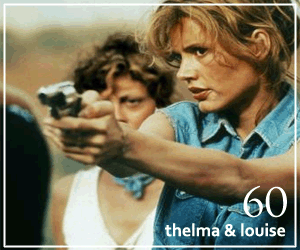 60. Thelma & Louise (Scott, 1991) 60. Thelma & Louise (Scott, 1991)
When their fateful vacation begins, docile Thelma (Geena Davis) — dominated and cheated on by her cartoonish buffoon of a husband (the only man she’s ever been with) — takes one of Louise’s (Susan Sarandon) cigarettes and pretends to smoke it. “I’m being Louise,” she says. By the end, chased by the authorities who are closing in, she lights one up for real. This is one example of the role reversal of the two women, and the extent to which both have succumbed to unconscious desires. It’s no coincidence that Louise, outwardly the more implacable and sensible of the two, is the one who commits the murder that starts it all, not in an act of defence of her friend’s near-violation, but in a righteous feminine rage which makes sense only after dark allusions to a traumatic past in Texas. After the robbery of their getaway money by J.D. (Brad Pitt), Louise breaks down, at which point Thelma takes charge, robbing a convenience store with the good ole boy tactics she learned from J.D. himself. “Something’s crossed over in me. I can’t go back,” says Thelma towards the end of their odyssey. And it’s true. With escape nearly impossible, the women are propelled forward by unspoken, almost atavistic urges. A stern, bullying cop is locked in the boot (they take his sunglasses too!), and a lewd, pervy truck driver (inexplicably encountered numerous times) is given his comeuppance. In Thelma and Louise, near-rape, homicide, larceny and suicide are seen as more desirable than the quotidian existence of its protagonists. The life before their life as outlaws (or, rather, their mostly unseen life previous to the diegetic world of the film) is perceived to be almost a dream, not the other way around. “I don’t remember ever feelin’ this awake,” as Thelma says. This evoked feeling of altered states and perverse perceptions makes Ridley Scott's film akin to such varied explorations of female duality as Persona and Mulholland Dr. (and is given a visual counterpoint by Adrian Biddle's mobile, increasingly vertiginous ‘Scope photography). Their newfound autonomy will not be relinquished, no matter the consequences, as the film races toward its liberating ("Let's just keep going"), and intensely logical, conclusion. |
 59. Starship Troopers (Verhoeven, 1997)
59. Starship Troopers (Verhoeven, 1997)
One of the slyly funniest battle films ever made, Starship Troopers lets you know from the very first frame that you're in uncharted territory. Paul Verhoeven's crazed bugsplat of a film is alternately a cliched homage to '40s war films (via Leni Riefenstahl), a scathing attack on media propaganda, a Breakfast Club-style high school romance, a riff on John Ford's westerns, and — oh yes — a sci-fi special effects extravaganza. The way this film works on so many disgustingly fun levels, skewering its genres while simultaneously employing their tropes, makes this (sorry, The Thin Red Line) the decade's great war film. Dutch bad-boy director Paul Verhoeven seamlessly melds all of these cinematic elements, along with his trademark twisted take on sexual politics, to fashion an eye- and every other body part- popping roller coaster ride of a film. Refreshingly non-sexist and egalitarian (coed showers for the infantry!), this Robert Heinlein story (cast with the crème de la crème of C-list actors) follows a tight-knit group of high school friends who enthusiastically enlist with the Federation to travel off-planet in hopes of saving humanity from the onslaught of ferocious, deadly (and smart!) giant bugs. Ashley Judd never had it so good. While the film's pulse-quickening battles with a variety of arachnids are thrillingly visceral (and viscera filled), it's the random throwaway moments of twisted humor that leave the lasting impression: a mother's maniacal laughter as her children gleefully squish cockroaches underfoot, Denise Richards' unending Pepsodent smile as she maneuvers a mammoth spaceship from its docking bay, a scientist's probing of a giant bug's gaping orifice blocked out by a black "CENSORED" box, two infantrymen's unsuppressed look of glee as a general is taken out by a giant winged bug… Lurking beneath Starship Troopers' pulp science-fiction surface lies a wealth of razor-sharp social commentary. Sometimes one finds the most surprising and subversive messages where one least expects them. And it's a slimy fun ride to boot. |
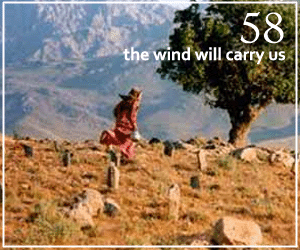 58. The Wind Will Carry Us (Kiarostami, 1999)
58. The Wind Will Carry Us (Kiarostami, 1999)
Hailed by many critics as the most influential director of the 1990s, Abbas Kiarostami celebrates the human spirit in The Wind Will Carry Us, a cinematic tone poem that Village Voice critic J. Hoberman describes as a "film about nothing and everything. Life. Death. The quality of light on dusty hills." It is, he states, Kiarostami's masterpiece. A filmmaker posing as an archaeologist travels from Tehran with his crew to a remote Kurdish village in Northern Iran. Passing themselves off as searchers for buried treasure and old relics, their true mission is a secret affair. They have come to this dusty agricultural town to record the rites of a traditional secret funeral ceremony indigenous to the region. The oldest woman in the village is close to death and the townspeople are keeping constant vigil. Originally planned as a 3-day excursion, the crew find their stay extended indefinitely as the woman clings to life with a stubborn tenacity. A local boy, her grandson, acts as their guide and informant on the woman's slow demise. With nothing but time on his hands, the filmmaker from Tehran attempts to befriend the villagers and quell the crew's impatience. His results are not always successful. Abandoned by his crew, he stays on until the woman's death and leaves the town, perhaps a changed man. Taking its rhythm from the laconic pace of the villagers' lives, The Wind Will Carry Us takes its time. Modernity butts heads with tradition and Kiarostami suggests that it might be advisable to slow down and settle in with the tempo he and the townsfolk and the goats, cows and chickens are setting. While stylistically sophisticated, the film is quite modest, but be prepared for the impact of the final tapestry woven with such simple yarn by the hands of a master image maker, one adept at creating frames of breathtaking beauty and simplicity with philosophical and symbolic overtones. Much of the film concerns itself with what is invisible. In actuality, the crew members (who are never seen) are looking for a hidden treasure. Most of their time is spent in idleness waiting for the old woman to die. Only through her death can they witness the mysterious ritual performed by the surviving village women. What is to be learned from observing this hidden rite? A schoolteacher informs the filmmaker that the ritual is not sacred. It is, in fact, based on economics and the most extreme mourners are often rewarded. To him it holds little interest. Darkness is a motif. A young man spends his days digging ditches for telecommunication cables in the old cemetery. His young fiancee is a milkmaid. She tends her animals in the pitch black of a subterranean cavern. She has no need of a lantern. She has become accustomed to living in the dark. Our visiting filmmaker goes to great lengths trying to glimpse the girl's face. She will not allow it. Neither can he see the ditchdigger nor gain entrance into the old lady's house. The lure of the unseen grows stronger as his access to the hidden is prohibited. Meanwhile, Kiarostami's screen is ablaze with sunlight on impossibly beautiful fields of golden grain and violet mountains. Riding through this countryside on the back of the village doctor's motorbike, our filmmaker is enroute to get morphine tablets for the dying woman. Incessantly inquiring on the woman's condition, he is admonished by the doctor to talk less and to take in the scenery. "Death is the worst illness," says the doctor. "When you close your eyes on the beauty of nature and the generosity of God, it means you will never be coming back. They say the other world is more beautiful but who has come back from there to tell us if it is beautiful or not?" "Prefer the present." Serene and lyrical, The Wind Will Carry Us is a gloriously hypnotic exploration of a world we inhabit temporarily. Through observing the lives of these simple villagers (all non-actors and thoroughly memorable), we are reminded that the beauty and poetry of this world is available to us all if we keep our eyes wide open. |
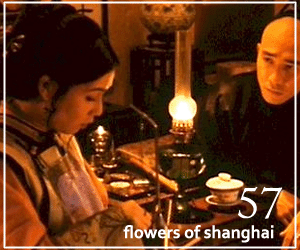 57. Flowers of Shanghai (Hou, 1998)
57. Flowers of Shanghai (Hou, 1998)
Taiwanese director Hou Hsiao-hsien was voted "Director of the Decade" during a Village Voice/Film Comment critics poll in the 1990s, beating out fierce competition like Wong Kar-wai, Abbas Kiarostami and Lars von Trier. He is widely regarded as Yasujiro Ozu's cinematic successor and this assessment is ironically appropriate in Hou's most Altman-esque film, Flowers of Shanghai, which tells the interconnected stories of various characters in four elegant brothels (or "Flower Houses"). In 19th century British-occupied Shanghai, the four "Flower Girls" are revealed to be: Crimson, who is in Huifang; Pearl, who is in Gongyang; Emerald, who is in Shangren; and Jasmine, who is in East Hexing. The various affairs are told through contemplative deep-focus shots in darkly lit rooms. Although there are lots of characters involved in the film, Hou selects the essential conversations as different pieces to the whole story. It is evident in this film that Hou has been gradually moving towards greater simplicity and utmost spareness in his films. His very slow observations on the various characters have been criticized as languid and tedious, but these actually allow the film to unfold without too much interference. Flowers of Shanghai consequently is able to capture the emotional subtleties and social complexities of courtesan-master relationships without superfluous narrative excesses, reminiscent of Mizoguchi's Women of the Night or Shinoda's Double Suicide. Definitely one of the iconic works of the 1990s, this richly sumptuous period piece is a study of how interconnected our lives are and how social conventions can hamper our own capacity to freely express true emotions. As the four drunkard men play mah jong around the centerpiece table, talking trivialities in life, the real and palpable emotional turmoil in the brothels occurs at the wayside. This narrative effect is so devastating that, coupled with Hou's meticulous filmic contemplations, it makes Flowers of Shanghai a beautifully tragic and a tragically beautiful film. |
 56. Underground (Kusturica, 1995) 56. Underground (Kusturica, 1995)
A more hysteric and cheerful companion to Angelopoulos’ Ulysses’ Gaze is Kusturica’s Cannes-winning salute to the disintegration of Yugoslavia in Underground. The film that was made under severe difficulties during the height of the Yugoslavian civil war deconstructs the deconstruction of the federation with a surprising charm, concluding that ”Yugoslavia,” as its horrific endgame, must have been a fable; and as a fairy tale of hatred, Underground trots along with never-ceasing, trumpets-in-the-bathroom enthusiasm. Being wedding and funeral in one, Kusturica's film devotes itself completely to this roller coaster of emotions that can only end in heartbreak and ghastly death. Underground, displaying man’s never-ending willingness to survive, is both a testament to the failure of humanity and the success of selfishness and misunderstanding; and Kusturica’s hyper magic realism with great insight reveals the abyss of pain that is left when an entire reality with all of its history violently evaporates. A frustrating view, Underground is also completely successful, and as a paradox the size of Yugoslavia itself, the film works miraculously. |
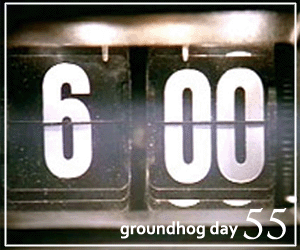 55. Groundhog Day (Ramis, 1993) 55. Groundhog Day (Ramis, 1993)
Life is a series of realizations. Realizing you've passed an opportunity, said the wrong thing, forgot to do the right thing, and, in the end, all you're left with is what-might-have-been. For Phil Connors (Bill Murray), such philosophical possibilities don't even begin to occur. Phil is an insufferable asshole, a man who thinks because he's a local weatherman, he's a big shot. Phil overrates his importance to the point of utter detestability, and there's a sadistic glee in seeing him in this hell he cannot escape. But Murray's performance is richer than that. It reveals a man who overrates his importance because he has nothing else, and as he moves from abusing his hell to learning how to become a better person, it changes from hell to purgatory to apotheosis. It's not just about learning how to impress Andie MacDowell. It's about learning to play Rachmaninoff's Rhapsody on a Theme of Paganini. It's about trying to save an old homeless man, how to make ice sculptures, and accepting that, even though winter is cold, it's just another part of the year. Two things make this film: the masterful script from Harold Ramis and Danny Rubin, and Bill Murray's beautifully funny performance. For Murray, this is a transition between the outrageously funny work of the '80s in the Ghostbusters/Caddyshack-type films, and the more nuanced work of films like Rushmore and Lost in Translation. Given this film is essentially a prolonged character study, the wrong actor as Phil Connors would have been a disaster. In Murray's hands, it's a miracle. And the script is perfect. It makes the right choice of not explaining what's going on. Phil simply is in Groundhog Day, and we have to figure out alongside him what he needs to do. It refuses to spell out for us what we should take away from it, while remaining consistently entertaining — it's Beckett by way of Second City. And when Phil wakes up on that hard-won new day, it could not be more touching. Groundhog Day reminds us that comedy can be just as thought-provoking and moving as any tragedy. It's about taking that chance to make mistakes and try new things and, ultimately, instead of realizing what might have been, realizing what could be. |
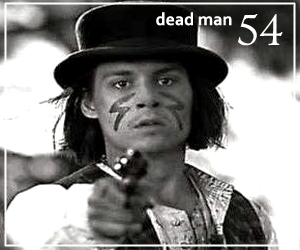 54. Dead Man (Jarmusch, 1995) 54. Dead Man (Jarmusch, 1995)
Dead Man has been called a Psychedelic Western and a Postmodern Western. Jim Jarmusch himself has called it an Acid Western. Perhaps, one can call it an Absurdist Western as well. Although poignant and grittily composed, it takes the viewer on a raucous journey to the American frontier that is both playful and violent, spiritual and humorous. One that defies all expectations of the Western genre. Parts of this journey are slapstick-ish and surreal with a frontier that is populated by colorfully rough and unusually offbeat characters, some of whom may, at first glance, seem a bit out of place in the American West. The mood Jarmusch conveys is part John Ford and part Through the Looking-Glass. Johnny Depp stars as William Blake, a young milquetoast from Cleveland. Recently orphaned and jilted by his fiancee, he travels West after being hired as a clerk in a frontier town called Machine, only to be informed by his employer, Mr. Dickinson (Robert Mitchum in a crusty, clever and hilarious final performance) that his position had already been filled. To make matters worse he is shot by Dickinson's son, Charley (Gabriel Byrne) on being discovered in the arms of his ex-lover. After murdering Charley, he escapes on a stolen pinto. Suddenly this unwanted man is indeed wanted by Dickinson. Dead or alive. With a bounty on his head and delirious from his wound, he is befriended by a large, bearlike Native American named Nobody (Gary Farmer) who mistakes him for the British poet, William Blake. Knowing that death is imminent, Nobody accompanies Blake on a final journey and serves as both protector and mentor. Rife with irony and humour, Dead Man shows us a West, a savage final frontier, that is a heartless cultural cemetery. It boasts an understanding of Native American civilization and depicts it with an unprecedented liveliness and respect. This frontier is a savage place where the tamers of the wild are the untamed and the so-called savages are poetic philosophers. Starkly and majestically shot in black and white by Robby Muller and merrily acted by a band of lively performers (including Billy Bob Thornton, Iggy Pop, Alfred Molina), Jarmusch's darkly funny masterpiece intelligently and subversively paints a portrait of a greedily expanding, self-destructive culture that is beginning to devour its own tail. Of special note is the haunting, elegiac score by Neil Young that punctuates the film with eerily beautiful and bullet-like guitar riffs and unsettling percussion. |
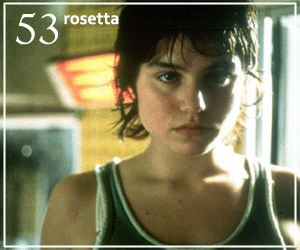 53. Rosetta (Dardenne & Dardenne, 1999)
53. Rosetta (Dardenne & Dardenne, 1999)
Luc and Jean-Pierre Dardenne’s Palme d'Or-winning Rosetta was an omen of the Cannes jury's Bressonian sensibilities that year (Bruno Dumont's L'humanité won the Grand Prix). Starting with La Promesse, then this film, and continuing with features like Le fils and L'Enfant, the Dardenne brothers prove that they might just be the heirs apparent to the late great Robert Bresson. Indeed, the other breakout directors of the past decade like Apichatpong Weerasethakul and Jia Zhang-ke can trace their creative roots to Bresson. In this unflinchingly truthful and socially conscious film, the Dardennes use a Mouchette-esque approach to tell the story of a young girl coming of age amidst bleak socioeconomic conditions. Characters like this are usually not featured in films because they are basically the ignored sectors of society — trash gradually being sucked into social nothingness. But Rosetta gives and shows the complex life and the humanity of these people. As the title character Rosetta, Émilie Dequenne portrays her role with such honesty and command that one cannot avoid comparisons to other great performances in film. Determined to overcome the hurdles of her bleak life — an alcoholic mother, the evils of unemployment, the indifference of people in general — Rosetta clings to her wits and spirit in becoming a productive part of society. Her only friend is Riquet (Fabrizio Rongione), but even this friendship is put to the morality test by Rosetta's quest for socioeconomic redemption. Life is tough, but is made tougher when resources (physical and financial) are scarce. The Dardennes' hand-held camerawork is, in a way, a window to Rosetta's soul but also our eyes to how Rosetta perceives the world. The cinematography is a work of formalistic rigour that unflinchingly wields its power. This is honest filmmaking at its finest, devoid of saccharine sentimentality and narrative intrusion. Social conscience is put to film in Rosetta — so endearing in its impact and eternal in its relevance. Bresson once remarked, "Make visible what, without you, might perhaps never have been seen." With Rosetta, the Dardennes did just that. |
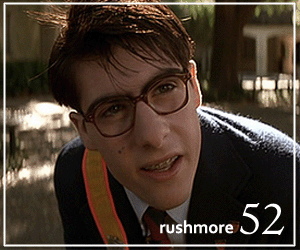 52. Rushmore (Anderson, 1998) 52. Rushmore (Anderson, 1998)
Wes Anderson is one of the two or three most exciting new American directors of the last 20 years, yet the fact that he can't make another Rushmore keeps getting held against him. It's not that his films after Rushmore have been terrible or somehow off the mark (they haven't). It's that Rushmore is one of the most thrilling statements of purpose in recent American film, a movie that lays out exactly what you can expect from a Wes Anderson film in the years to come in as succinct and hilarious a fashion as possible. There's the fussed over production design, the mannered performances, the weird melancholy and the slow-motion shots, as well as the wide angle lenses and other technical quirks Anderson employs in nearly all of his films. Perhaps Rushmore is still everyone's favorite Wes Anderson film because it's a wonderful blast of adolescent longing, something nearly anyone can identify with. Sure, there's all of the great sight gags and minimalist line readings that drive the humor in an Anderson film, but there's also an undercurrent of the characters never being able to get what they want. Jason Schwartzman's Max Fischer is all pent-up desire, facing a world where he's in love and somehow unable to express that in any way, shape or form without scaring off the woman he loves. At the same time, Bill Murray (in what remains a career best performance) plays the so-rich-he-doesn't-have-to-give-a-shit Herman Blume, a man whose contact with Max ends up making him give a shit indeed. But this isn't a heartwarming comedy about how two men come to realize that life is worth living. There's a nasty chill of cynicism at its center that only gradually gives way to something approaching a heart. The movie's title is the name of the school Max gets kicked out of, yes, but it's also an ideal neither man can hope to attain, a pinnacle of life that will forever haunt them. |
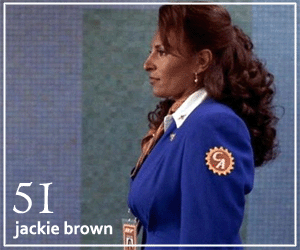 51. Jackie Brown (Tarantino, 1997) 51. Jackie Brown (Tarantino, 1997)
Starting out with an homage to Mike Nichols' iconic film The Graduate, Quentin Tarantino introduces us to a female character with as much strength and individuality as the beloved Mrs. Robinson. Jackie Brown is a flight attendant for a Mexican airline and in her spare time she helps a pimp gunrunner out. Brown is a single independent woman. However, the difference between Benjamin riding the airport escalator and Mrs. Brown — both are at very different significant points in their lives. While doors are being opened for Benjamin, doors could soon be closing for Jackie. Jackie's scrappy, tho. And when pressed against the wall with heat from the police force, she finds a way to turn a serious situation that could penalize her for life — into an opportunity to begin a new one. The film has the usual suspects of a Tarantino picture: druggies, sellers, pimps, hoes, and other shady characters you may find in a 1970s Blaxploitation film. In fact, Pam Grier, who portrays Jackie, was a star of such films as Foxy Brown and Coffy. The dialogue is just as entertaining as the plot, and the actors, uniformly and true to a QT production, give their all. |
| © 2010 INTERNATIONAL CINEPHILE SOCIETY. ALL RIGHTS RESERVED. | ICS - 100 - 90 - 80 - 70 - 60 - 50 - 40 - 30 - 20 - 10 |